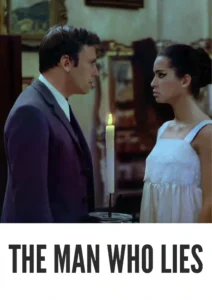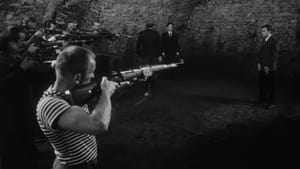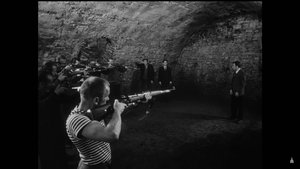Contact: info@alwanfilm.com
Video Sources 0 Views
- The Man Who Lies

Synopsis
Table of Contents
ToggleReview: The Man Who Lies 1968 Colorized – A Captivating Tale of Deception and Memory

Introduction
The Man Who Lies 1968 is a cinematic gem that delves into the complexities of truth, memory, and identity. Directed by Alain Robbe-Grillet, this film stands out for its innovative narrative structure and intriguing themes. In this article, we will explore the impact of colorization on the viewing experience of “The Man Who Lies” (1968) and discuss its importance in the context of film history.
Check The Full Colorized Movies List
Check Our Colorized Movies Trailer Channel
Understanding The Man Who Lies 1968 Colorized: Director, Cast, and Genre
Alain Robbe-Grillet, known for his contributions to the Nouveau Roman (New Novel) literary movement, brings his distinctive narrative style to The Man Who Lies 1968. The film stars Jean-Louis Trintignant in a compelling performance as the enigmatic protagonist, Boris Varissa. This psychological drama, tinged with elements of mystery and surrealism, explores the unreliable nature of memory and truth, making it a landmark in avant-garde cinema.
Exploring the World of The Man Who Lies 1968 Colorized: Plot and Characters
The Man Who Lies 1968 is set in a small, unnamed European village, where Boris Varissa arrives claiming to be a resistance hero during World War II. He tells conflicting stories about his past, weaving a web of lies that confuses both the villagers and the audience. As the narrative unfolds, it becomes increasingly difficult to discern reality from fabrication, reflecting the film’s exploration of the subjective nature of truth and memory. Supporting characters, including the village women who are drawn to Boris’s charisma, add depth and complexity to the story.
The Art of Film Colorization
Film colorization involves digitally adding color to black and white films, transforming their visual presentation. This process has evolved significantly since its inception, with modern techniques offering more nuanced and realistic results. Colorization can enhance the viewing experience by making classic films more accessible and appealing to contemporary audiences, while also highlighting details that may have been overlooked in monochrome.
Early Colored Films: A Brief History
The journey of color in cinema began with hand-tinted frames and evolved through various technological advancements, including Technicolor and Eastmancolor. Early colored films often faced technical challenges and limitations, but they paved the way for the vibrant and immersive visual experiences that modern audiences enjoy. These pioneering efforts laid the groundwork for the sophisticated colorization techniques used today.
The Man Who Lies 1968 and Its Early Colored Version
Releasing The Man Who Lies 1968 in a colorized format was a bold decision aimed at reintroducing the film to a new generation. The colorization process brought new dimensions to Robbe-Grillet’s intricate visual storytelling, highlighting the film’s surrealistic elements and enhancing its atmospheric mood. The vibrant colors add a layer of visual complexity that complements the film’s enigmatic narrative.
The Debate Over Film Colorization
The practice of colorizing classic films remains a contentious issue within the film community. Proponents argue that colorization makes older films more accessible and engaging for modern audiences, potentially revitalizing interest in classic cinema. Critics, however, contend that it can compromise the artistic integrity and historical authenticity of the original works. This ongoing debate underscores the tension between preserving cinematic heritage and adapting it for contemporary tastes.
Examining The Man Who Lies 1968 as an Early Colored Film
Colorization has a unique impact on “The Man Who Lies” (1968), enhancing its dreamlike quality and surrealist aesthetics. The added color emphasizes the contrast between the protagonist’s various tales, making the distinctions and overlaps between his conflicting narratives more visually pronounced. While some purists may prefer the original black and white version for its stark and ambiguous atmosphere, the colorized version offers a fresh perspective that enriches the viewing experience.
Influence and Legacy: The Man Who Lies 1968 Colorized’s Impact on Cinema
“The Man Who Lies” (1968) has left a lasting impression on the world of avant-garde cinema. Its innovative narrative structure and exploration of unreliable memory have influenced countless filmmakers and storytellers. The film’s legacy can be seen in works that challenge conventional storytelling techniques and delve into the complexities of human perception and identity.
Director’s Cinematic Legacy: Beyond The Man Who Lies 1968 Colorized
Alain Robbe-Grillet’s contributions to both literature and cinema are profound. Beyond “The Man Who Lies” (1968), his filmography includes other groundbreaking works such as “Last Year at Marienbad” and “Trans-Europ-Express.” Robbe-Grillet’s distinctive approach to narrative and his willingness to experiment with form and structure have cemented his place as a pioneer of modernist cinema, influencing a wide range of filmmakers across different genres and generations.
Themes Explored in The Man Who Lies 1968 Colorized
“The Man Who Lies” (1968) delves into themes of deception, memory, and identity. The film challenges viewers to question the nature of truth and the reliability of personal narratives. Through Boris’s conflicting stories, the film explores how memory can be manipulated and how subjective experiences shape our understanding of reality. These themes are presented with a blend of psychological drama and surrealist aesthetics, creating a rich tapestry of philosophical inquiry.
Reception and Controversy Surrounding The Man Who Lies 1968 Colorized
Upon its release, “The Man Who Lies” (1968) garnered mixed reviews. Some critics praised its innovative narrative and thought-provoking themes, while others found its ambiguity and non-linear structure challenging. The colorized version of the film has sparked additional controversy, with debates about its impact on Robbe-Grillet’s original vision. Despite these controversies, the film has achieved cult status and remains a significant work in the study of experimental cinema.
Where to Watch The Man Who Lies 1968 Colorized Online
For those eager to experience “The Man Who Lies” (1968), the film is available on various streaming platforms, including Criterion Channel, Amazon Prime, and MUBI. Both the original black and white version and the colorized edition offer unique viewing experiences, allowing audiences to choose how they wish to engage with Robbe-Grillet’s intricate narrative.
FAQs About The Man Who Lies 1968 Colorized
Q: Is The Man Who Lies 1968 based on a true story? A: No, “The Man Who Lies” (1968) is a work of fiction, crafted by Alain Robbe-Grillet. The film’s narrative, characterized by its unreliable storytelling and fragmented structure, is a reflection of Robbe-Grillet’s literary and cinematic style, rather than a recounting of real events.
Q: Who are the main actors in The Man Who Lies 1968? A: The film stars Jean-Louis Trintignant as the enigmatic protagonist, Boris Varissa. His performance is complemented by a strong supporting cast, including Sylvie Bréal and Zuzana Kocúriková, who bring depth and nuance to the film’s complex narrative.
Q: What awards did The Man Who Lies 1968 win? A: While “The Man Who Lies” (1968) did not receive major awards, it has been highly regarded in academic and critical circles for its innovative approach to storytelling and its contribution to the avant-garde cinema movement.
Q: Why was The Man Who Lies 1968 released in a colorized format? A: The decision to release “The Man Who Lies” (1968) in a colorized format was aimed at revitalizing the film for contemporary audiences. The colorization process highlights the film’s surrealist elements and adds a new layer of visual intrigue, making the narrative’s complexities more accessible to modern viewers.
Q: How does the colorization of The Man Who Lies 1968 affect its viewing experience? A: The colorization of “The Man Who Lies” (1968) enhances its surreal and dreamlike qualities, emphasizing the distinctions and overlaps in Boris’s conflicting stories. While some purists may prefer the original black and white version for its starkness, the colorized edition offers a fresh perspective that enriches the visual and narrative experience.
Q: Where can I watch The Man Who Lies 1968? A: “The Man Who Lies” (1968) is available on several streaming platforms, including Criterion Channel, Amazon Prime, and MUBI. Both the original and colorized versions are accessible, allowing viewers to choose their preferred format.
Q: What makes “The Man Who Lies” (1968) significant in film history? A: “The Man Who Lies” (1968) is significant for its innovative narrative structure, its exploration of unreliable memory and truth, and its influence on avant-garde cinema. Alain Robbe-Grillet’s unique approach to storytelling challenges conventional cinematic norms and has inspired numerous filmmakers and storytellers.
Q: What themes are explored in “The Man Who Lies” (1968)? A: The film delves into themes of deception, memory, identity, and the subjective nature of truth. Through its intricate narrative and complex characters, “The Man Who Lies” (1968) invites viewers to question the reliability of personal narratives and the fluidity of memory.
Q: How does “The Man Who Lies” (1968) fit into Alain Robbe-Grillet’s body of work? A: “The Man Who Lies” (1968) is a quintessential example of Robbe-Grillet’s narrative style, characterized by its non-linear structure, fragmented storytelling, and exploration of philosophical themes. The film aligns with his broader body of work, including “Last Year at Marienbad” and “Trans-Europ-Express,” which similarly challenge traditional narrative conventions and delve into the complexities of human perception.
Conclusion
“The Man Who Lies” (1968) stands as a testament to the power of innovative storytelling and the enduring allure of cinema that challenges conventional norms. As audiences journey through the labyrinthine narrative of “The Man Who Lies” (1968), they are invited to confront the elusive nature of truth and the malleability of memory. Alain Robbe-Grillet’s masterful direction, coupled with Jean-Louis Trintignant’s mesmerizing performance, creates an immersive cinematic experience that lingers in the mind long after the credits roll.
In the ongoing debate surrounding the colorization of classic films, “The Man Who Lies” (1968) serves as a compelling case study. The addition of color breathes new life into Robbe-Grillet’s surreal landscapes, enhancing the film’s dreamlike quality and accentuating its thematic depth. While purists may argue for the preservation of the original black and white version, the colorized edition offers a fresh perspective that invites viewers to rediscover the film in a new light.
As we reflect on the enduring legacy of “The Man Who Lies” (1968), let us celebrate its status as a pioneering work of avant-garde cinema. Through its exploration of deception, memory, and identity, the film continues to captivate and intrigue audiences, challenging them to question their perceptions of reality and embrace the inherent ambiguity of the human experience.
So, whether you choose to experience “The Man Who Lies” (1968) in its original black and white form or the vibrant colors of its colorized edition, one thing remains certain: the film’s enigmatic allure will continue to fascinate and inspire generations of cinephiles for years to come.













